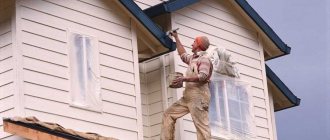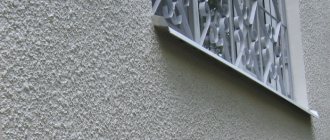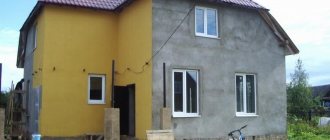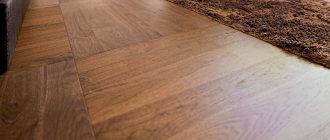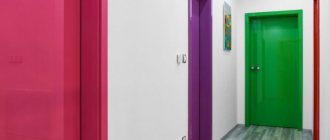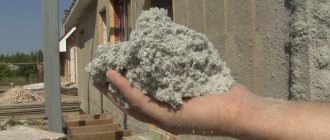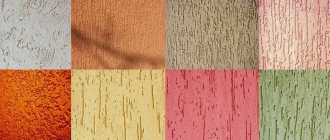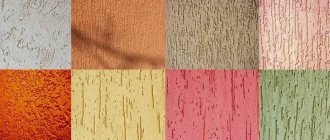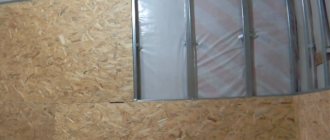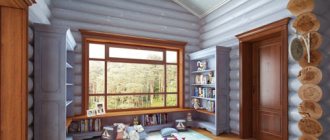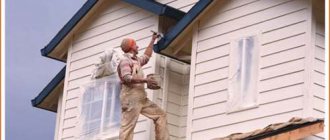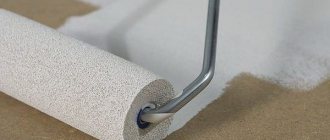When the need arises to paint a new house made of logs or profiled timber, the first question that arises before its owner is: how to paint the outside of a wooden house? Today there are so many different materials advertised by their manufacturers that it is very difficult to independently determine which paint to choose for exterior painting. But everyone knows that the quality of painting and the durability of the coating largely depend on the chosen material. In the article you will get answers to the questions: what is the best way to paint the facade of a wooden house, how to choose paint, and at the same time you will learn how to properly paint a wooden house with your own hands so that it will delight you with its beauty for many years.
Preparing a log house for painting
First of all, you must clearly understand that the result will differ from what was expected. In 90-95% of cases, the color does not match, the paint does not adhere properly, and consumption increases as painting progresses. Experienced painters, when calculating the required amount of paint, always add up to 30% of the supply, since it will almost certainly be used. Key points to consider:
- It is necessary to select paint based on the color of the joint sealant or an easily painted shade that will not affect the color of the building outside. Painting the walls should be done quickly, and work with the sealant will have to be done after the timber has settled.
- Sometimes, when painting takes longer, the wall may have a different tone. To avoid this effect, the outside of the log house is bleached with special compounds. After leveling the tone of the walls, the log house is treated with an antiseptic and painted.
- Compliance with painting technology deserves special attention: paint dilution for the starting layer, drying time of the layers. Ignoring this nuance, the walls will soon begin to peel off.
- Immediately before painting, it is necessary to blow out any remaining dust and sanding from all cracks with an air compressor or vacuum cleaner.
- If the log house is painted with brushes, then 2 layers will be enough to achieve a reliable and durable coating. If you work with a spray gun, you will need at least 3-4 layers.
- Walls painted with a roller or brush turn out matte, while with a spray gun they turn out to be more glossy and shiny. Since it is necessary to paint a log house quickly, it is better to use a spray gun if it does not matter to you whether the final log house will be matte or glossy.
- It is not advisable to use paints for interior decoration outside the house, and vice versa. Since manufacturers produce paints based on chemical solvents - for exterior use, and water-based - for interior use. Using them for other purposes is not only ineffective, but also harmful.
- The lack of sanding cannot be hidden under paint! No matter how many layers you apply, unsanded or poorly sanded logs will become a carrier of dust, which will remain on the rough surface.
- If the sharp edges and corners of a wooden structure are rounded and sanded, the paint on them will last longer.
- The color of the sample boards will, as a rule, differ from the final color of your walls. It's not the color or gloss itself, but the huge difference in the area of objects.
There is also a drawback to painting a log house for all those who love the smell of wood - this pleasant aroma will disappear after applying the first layer of paint. However, ease of breathing, fresh air, warmth in the winter months and coolness in the summer - all this will remain.
What color should the façade be painted?
When a homeowner decides to paint the facade of his wooden house, he often has to agonize over the choice of color, which will be, in a way, the calling card of the house.
Which color should I choose? To use one color or several for the facade, to place patterns on the walls of the house or to cover it with a solid color - these are only a small part of the questions that home owners are looking for answers to. In fact, a lot depends on your tastes and the area surrounding the house. Otherwise, there are no restrictions. But nevertheless, some advice should be given on choosing a color so that the house has a more or less aesthetically attractive appearance. Houses located in southern latitudes are usually painted in cool colors (blue, white, purple, etc.). And those houses that are located in northern latitudes, as a rule, are painted in warm colors (yellow, green, orange, and so on). This is done in order to highlight the house against the general background, by creating a contrast with the surrounding environment. Perhaps many have seen the colorful houses of Scandinavian towns and villages covered with snow. Agree that they look simply wonderful. Imagine if the houses in the snowy valley were painted white, you might not even see them from a distance. If you like rigor in design, then gray can serve as a color solution. However, it should be noted that you should not choose a shade that is too dark, as it will deprive the house of severity and make it look like a dark spot where decorative elements will not be visible. Those homeowners who want to paint their home but don't want to lose the natural color can choose light yellow, light brown or even dark brown paint. This color will add saturation and will not deprive it of naturalness. And if you apply the paint in a thin layer, you can even see the wood grain through it.
Useful tips
- For the exterior walls of the log house, it is advisable to choose dark colors - this will help protect it from exposure to sunlight. On the street side, it is not at all necessary to use water-based paint; you can also use it containing alkyd resins (based on a chemical solvent).
- It is better not to treat the steam room with glazes and paints, because this room has the highest temperature and humidity. For this purpose, you can use water-resistant, heat-resistant acrylic varnishes based on water. Their use will protect and emphasize the structure of the wood, avoid a strong odor, and make it possible to touch the walls without the risk of getting burned.
- In the washing room, it should be taken into account that here all surfaces often come into contact with hot water and steam. This makes them vulnerable to rot and insect pests. Before painting, this room must be treated as thoroughly as possible with an antiseptic.
- After impregnation, it is better to cover the remaining rooms inside the log house with varnishes or paints based on water, and not on a chemical basis.
- When choosing a protective impregnation, it is better to give preference to one that contains insect repellents.
- When painting outside walls, remember that the ends absorb paint more strongly. They can and should be applied 1-2 more layers.
- Chemical compounds must be applied only to previously cleaned and dry surfaces.
- Before you start painting the floor, it should be treated in several layers with moisture-proof and antibacterial impregnations.
These simple recommendations will help you easily cope with cosmetic repairs and significantly extend the life of the structure. If you take care of your bathhouse in a timely manner and competently make minor repairs, it will please the owners for a long time.
Types of antiseptic impregnations
We should start the review with washable wood preservatives. They are made on an alkyd-alcohol base, which also includes metal salts. But, as the name suggests, such products are washed away. That is, it is useless to use such an antiseptic when treating the outer sides of walls - after a short time the composition will be removed from the structure. But internal processing can be done using this impregnation, since it is harmless to human health.
The opposite of the remedy described above is a hard-to-wash antiseptic. This is a product based on a combination of synthetic and vegetable oil. This type of painting of a log house can be applied to both external and internal walls. Hard-to-wash-out impregnations remain resistant to precipitation and fully meet environmental safety requirements.
How to paint the walls of a bathhouse from the inside
Painting the walls of a bathhouse requires a special approach. Logs inside the house are constantly exposed to heat and moisture. Some types of wood are not painted at all, but over time the surface of the walls darkens, so it is better to protect them.
The paint must withstand a temperature range from -25 to +120 degrees. Another requirement for paint quality is elasticity. This property ensures that the coating layer will not crack. Cracks lead to a decrease in the protection of the wall surface from moisture.
Most often, when treating interior walls after sanding, water-based varnishes are used. They protect the surface from moisture and rot, preserving the color and aroma of natural wood.
Foreign and Russian manufacturers produce special products for painting Finnish hot air saunas and Russian baths with high humidity. These products include antibacterial components that protect the surface of the walls from fungus. If the paint is chosen correctly, drops of moisture flow down the walls without being absorbed into them.
The shelves in the bathhouse are covered with oil or wax impregnation. The mixture is thoroughly rubbed into the surface to protect the wood from cracking, darkening and bacteria. Varnish cannot be used for these purposes, because the wood will heat up in the sauna so much that it will be impossible to sit on it.
Thus, in order to preserve the attractive appearance of walls made of natural logs and preserve the ability of wood to regulate the level of humidity in the house, it is advisable to use water-based paints. When preparing walls after sanding for the next stage of processing, carefully select mixtures for bioprotection. Such impregnations should not create a vapor-proof film on the surface. The same requirements apply to means for improving the fire resistance of wooden walls.
Painting wood will help maintain the attractive appearance of the house, make it more comfortable inside and extend the life of the log house.
Requirements for paints
After drying, the compositions have different textures and colors. Previously, the outer walls of a chopped bathhouse were covered with oil paint, but under such a layer the wood does not breathe, since the film does not allow steam to pass through.
The paint layer should allow steam to escape so that mold and microorganisms do not develop under it. The surface should not fade or become dull over time.
Vapor permeability
This is one of the important parameters when choosing paint. The walls of the bathhouse conduct steam, which comes out from the inside, but it does not enter the air if the colorful film does not release it. As a result, the wall begins to rot, which gradually covers larger and larger areas.
The indicator that people pay attention to indicates the amount of moisture that a square of film can let through per day.
The basis
Impregnations ensure the safety of wood under a layer of paint
The base is acrylic, mineral particles, pigments; synthetic and natural latex are added to them. The solvent is organic matter, water, emulsion, oil. High-quality paints with a vapor-permeable effect are produced on the basis of plyolethyl resins. Enamels form an impenetrable film for steam.
Waterproof
The painted side should not absorb water from the outside, and the ability of the surface to accumulate dirt is also discouraged. For characterization, the moisture absorption coefficient of the paint is used.
Protection of decorative qualities
Paint and varnish are characterized by abrasion rates. The higher it is, the longer the layer will last in its original form. The smoothness of the surface is important so that dirt is easily washed off by rain from the surface. Decorative properties may change due to the action of wind and temperature changes, which must be taken into account when choosing.
UV resistance
The pigments in the composition change brightness under the influence of the sun, so protective components are added to the paints. The rays dry out the walls, kill microorganisms, but burn out the color of the paint. Ultraviolet leads to overdrying of the top layer of untreated wood and destroys it. The most resistant are polysilicon, acrylic, and silicone materials.
Preparing the house for painting
By the time of treatment, the wall surface should be clean and smooth. A set of appropriate measures can achieve this. First, you should wash the surfaces using soft abrasives. For example, a brush with plastic bristles can remove the most severe dirt, dust deposits, etc.
Next is washing. At this stage, it is advisable to use special sprayers and washers with high pressure, or use a regular garden hose. In extreme cases, wet cleaning with a rag is performed.
Next, the technological process of preparing the log house for painting involves cleaning it using a hard abrasive. If at the first stage the brush eliminated foreign bodies, then this time the purpose of the mechanical action will be to refine the structure of the tree itself. Use hand sanders or brushes with metal fibers to polish the wood.
Then the washing operation is repeated again, which will complete the preparation for painting.
How to paint a log house
- We clean the surface of the logs from the outside. The walls must be thoroughly washed from dust. To do this, use a soft brush and a damp cloth. There is no need to generously water the walls. They must dry thoroughly before the next step.
- We sand the walls. The walls should be smooth after sanding so that the paint will apply evenly. The surface of wooden logs is treated with sandpaper. Start with coarse-grained sandpaper and finish with fine-grained sandpaper. You can speed up the work if you use a grinder with an emery wheel for sanding.
- We cover the walls with protective compounds. Fire retardant impregnation is applied first, followed by bioprotection.
- Apply 2 layers of each product to the wall and wait until it dries completely. The instructions for the paint indicate the exact drying time for one layer.
- A water-repellent coating is applied. For this purpose, paints or special protective mixtures are used. After each coat of paint, the wall is allowed to dry for a couple of days. The first layer must be done with a brush. Subsequent layers can be applied using a spray gun, protecting the eyes with goggles and the respiratory tract with a respirator.
Modern industry produces painting materials that initially contain insect repellents and fire-retardant impregnations. The use of such mixtures can significantly speed up the painting of external walls after sanding.
Why and from what wood needs to be protected
The outer layer of wood, devoid of bark, is completely defenseless both from the destructive effects of wind and sudden fluctuations in humidity, and from insect pests. The risk increases if the house is located in a rural or wooded area. This is explained as follows:
- As a result of complete cleaning of the wood surface from bark, it is easier for wood-boring beetles to access it.
- Under the influence of constantly changing relative humidity levels throughout the year, mold appears on wooden houses over time (usually in inconspicuous places, where it is most difficult to remove).
- Moisture stains remaining on an unprotected surface provoke the development of fungal diseases on the wood.
- With constant weathering, the surface of the building changes its natural color, becoming dull brown, which is why a wooden house loses its aesthetic appearance.
Based on this, when a wooden house is ready, it should be subjected to surface sanding, antiseptic treatment, and then painting.
Painting logs on the outside has a number of advantages:
- paints and varnishes prevent destruction, dampness and rotting,
- antiseptic treatment protects the log house from pests, fungal mold and corrosion,
- Exterior painting provides an opportunity to create a façade that fits perfectly into the architecture of the house and landscape solutions.
Manufacturers and product prices
Bath paint is produced by domestic and foreign manufacturers. Its price depends on the material used and the quantity in the jar.
Belinka
The manufacturer's product range consists of paints, glazing compounds, varnishes, and impregnations. They have a wide range of colors, which allows you to bring any design idea to life. When using materials, the structure of the wood is preserved. Belinka produces polyacrylate paints that have water-repellent and vapor-permeable properties.
Tex
Paint from the Russian manufacturer Tex has protective qualities, which guarantees an increase in service life. The company produces soil and glaze antiseptics, drying oils, wax compositions, and fire-retardant impregnation. This allows you to choose an acceptable option for painting the bathhouse.
Tikkurila
The compositions are produced by a Finnish company in accordance with innovative developments. After production, the compositions were tested in harsh climatic conditions. The materials are developed using special components that protect the coating from ultraviolet rays and the wall from excessive absorption of moisture and rot.
The range consists of acrylate, oil and polyacrylate compounds. The paints are certified by the European Union, which ensures their environmental friendliness. The paint has a high cost, which is explained by its excellent technical characteristics. Before applying the composition, areas that cannot be painted are covered.
Saikos
The compositions of the German manufacturer are developed on the basis of natural oils and waxes. This ensures the preservation of the structure for many years.
Choosing the right paint
Wood is a building material of natural origin and, unlike man-made brick and concrete, it reacts much more strongly to air humidity, wind, temperature fluctuations and solar radiation. Wood without bark can rot, burn out and become a haven for all kinds of molds and wood-boring beetles.
The factor that determines the service life and external decorative qualities of a log house is the choice of coating. Paints or impregnations for treating wooden façade walls are used to preserve wooden elements and must meet certain requirements:
- Create a surface protective layer that protects the wood from rain, snow and atmospheric moisture. Be frost-resistant (not destroyed by cyclical temperature changes).
- Have UV protection . Direct sunlight causes unprotected wood to change color (tanning effect) and lose its attractiveness.
- Have good adhesion (adhesion to the plane of the facade) and absorbency (important when processing with impregnation; penetration depth is indicated in the instructions for the product).
The type of paint is chosen based on its protective properties and visual appeal Source derevyannyy.com
- Demonstrate lack of moisture absorption .
- Be environmentally friendly . A parameter that is especially relevant for a log bathhouse.
- Don't lose your attractiveness. Varnish and acrylic compositions should not lose their original gloss. Paints must retain their original color .
- Contain fire retardant and antiseptic additives. Modern dyes are capable of maintaining the safety of a wooden structure.
- Be abrasion resistant .
The market offers a wide range of products suitable for painting the facade of timber and log houses. Modern coatings make it possible to preserve and emphasize the naturalness of the facade material or completely hide it under a protective layer. When deciding how to paint the exterior of a log house, owners give preference to proven, certified products. In practice, several types of coatings are used, the characteristics of which are useful to have an idea of.
The use of certified paints is a guarantee of high-quality painting Source fasad.guru
Antiseptic impregnations (waxes, stains) and varnishes
Liquid antiseptic impregnations for wooden surfaces penetrate the wood structure to a depth of 0.5-1 cm and create a barrier to all threats, natural and weather. There are two types of antiseptics on sale:
- Wax . Water-based wax is perfectly absorbed into wood, without creating a continuous film and maintaining its breathable properties. When finishing the exterior of a log house, a colorless or glazing (translucent) composition is used, creating a mother-of-pearl effect or an additional shade on the surface. Gives the facade water-repellent properties, leaving the natural structure visible.
- Wood stain . The composition is a tinting (impregnating) agent that colors the facade and protects it from biological contamination. The coating is short-lived, so a varnish is applied on top, which can extend the life of the stain and enhance its protective properties.
Treatment of wooden elements with fire retardant Source optimal-r.ru
- Varnishes (colorless or colored) are a proven, reliable means of protecting facades. Both options do not hide the natural texture of the wood; colored varnish can highlight its color. Varnishes, glazing impregnations and wax are used for painting not only outside, but also inside homes, where non-toxicity and external decorativeness are especially important.
Acrylic (acrylate) paints
Water-based acrylic paints for treating the external walls of a log house are considered the most acceptable, high-quality option with many advantages:
- contain solvents ;
- dry quickly and form a durable, vapor-permeable film;
- protect the wooden facade from ultraviolet radiation ;
- durable (resistant to weather vagaries);
- They retain their original color and shine for a long time (7-8 years) .
Impeccable appearance of acrylic paint Source materialyinfo.ru
See also: Catalog of companies that specialize in finishing materials.
The construction market offers several types of paints:
- Water-based acrylic paints . It is a water-acrylic emulsion (composition of two immiscible elements). After application to a wooden wall, the water evaporates, leaving a thin film layer with attractive properties on the surface. The paint does not have a strong odor, is flexible enough not to deteriorate under the influence of low temperatures, is vapor permeable (allows the wood to breathe) and at the same time waterproofs the facade.
- Water-based latex paints . They also contain acrylic resins, and therefore they are elastic, do not fade under solar ultraviolet radiation and are resistant to abrasion. Synthetic latex in the paint makes the surface silky in appearance. This paint is used when processing facades, window and door openings, and fences.
Types of decorative impregnation with water-based acrylates Source plantu.ru
- Alkyd compositions . They are produced on the basis of alkyd resins, which remain in the surface layer of wood to form a protective glossy layer. This paint fades quickly, but is resistant to negative temperatures and high humidity; it is often used to paint doors and window frames.
The disadvantage of acrylic dyes is their fairly high price. When painting log walls, they can be replaced with less expensive acrylate paints and aqualacs based on acrylate resins and dispersions, which reduce costs. These compositions have similar characteristics, they are safe and beautiful, but are designed for a shorter service life.
Oil based paint
Oil paint for a log house, used externally, is a familiar and fairly common method of painting. Despite its modest consumer qualities, it continues to be used; more often for painting fences than residential buildings.
Oil paint is a budget way to update a facade Source pkr.grunfest.ru
Brand overview
When choosing varnishes, enamels and paints for painting baths and saunas, you should give preference to specialized lines, since the creators of such products take into account all the technical features and characteristics of wet rooms. The Finnish company Tikkurila is considered the absolute market leader in this segment. Among the most popular compositions from this manufacturer are the following.
- Supi Saunasuoja is a high-quality impregnation for interior coatings based on an aqueous solution with acrylic. Can be used in rooms where the temperature exceeds 100 degrees. Available in a condition suitable for tinting.
- Supi Laudesuoja – oil enamel, used for painting shelves in saunas.
- Supi Saunavaha - this varnish is considered a universal product intended for all types of bath surfaces.
Users note that imported formulations are very effective, especially when it comes to Finnish manufacturers. They have only one drawback - the high price. That is why some bathhouse owners prefer Russian manufacturers who offer cheaper lines. Here are a few brands that are in demand when painting bathhouses.
- “Senezh Sauna” is an acrylate antiseptic used to protect wood lining in bathhouses. Includes a fungicidal component and has no chemical odor.
- Neomid 200 is an effective coloring agent that includes antiseptic components. The composition is in demand when processing shelves, benches and other wood coverings in saunas and baths.
- Neomid Sauna is a translucent acrylic-based varnish, used for impregnation of wooden lining in steam rooms and other rooms with high humidity.
Design styles
Classic involves the use of white, cream, beige and light shades.
It is characterized by symmetry, precise forms, correct geometry and architecture. The interior is furnished with solid furniture and massive decorative elements. You will see paintings on the walls and voluminous vases on the floor, heavy curtains, lambrequins and draperies on the windows. The bedroom and living room are decorated in this style. It is desirable that the rooms have high ceilings, otherwise heavy curtains with draperies or lambrequins will make the space heavier and smaller. Classic style will make the room festive, romantic and luxurious.
Empire style is distinguished by red and bright, white and cream colors. Here you will see a lot of gilding and various decorations. To decorate this style, tablecloths, furniture covers and velvet curtains with embroidery, curls or drapery are used. To equip this design of a log house, heavy double doors and large furniture are installed. It is suitable for furnishing spacious rooms, such as a living room or dining room.
Art Deco emphasizes strict geometry and patterns. When decorating, geometric patterns and ornaments, stepped shapes and discreet stucco molding, wide lines and streamlined curves are used. Here you will not find bright colors and elements of romanticism. This style is characterized by halftones and predominantly dark colors, among which brown and beige, black and purple, and green are often used.
You can play on the contrast of black and white, black and purple, black and green. This style is distinguished by luxury and chic. Expensive materials are often used, including rare woods, silver, ivory, crocodile skin, etc. Art Deco is suitable for rooms with high ceilings.
Modern is a light, soft and sophisticated style that is suitable for a comfortable stay. Here they use light tones and muted colors, natural colors, smooth and flowing lines. You can see arches instead of doors, nature-themed wall paintings, light curtains and round tables.
Due to its closeness to naturalness and the use of natural motifs, modernism is perfect for decorating the interior of a log house. And since it encourages relaxation and creates a comfortable and cozy environment, a bedroom, a guest room, or a living room with a fireplace are decorated in this style.
High-tech is a modern and practical style that allows the use of open communication pipes. This simplifies finishing, but does not provide complete safety in a wooden house, as experts advise covering pipes and electrical wiring. When decorating this style, glass and metal, synthetic materials, sliding doors and transformable furniture are used.
Here you can often find panoramic windows, smooth and even surfaces, an effective combination of space and light. The main colors used are grey, metallic and silver, black and white. Small rooms are decorated in this style, as it allows you to save space and functionally distribute the space in the room. This is an attic, an office or a kitchen.
How to paint a log house correctly
To protect the walls of the house from the influence of precipitation, sunlight, wind, insects and mold, the walls of the log house are impregnated with special protective solutions and painted. In this way, the tree is protected from darkening, cracking of the ends of the logs, and the release of resin from cut knots.
When choosing a method of painting natural wood after sanding, they try to preserve its natural properties, leave the wood the opportunity to independently regulate the humidity in the house, and maintain the vapor permeability of the walls.
Sometimes only the outside surface of the walls is painted. For example, such a finish is often sufficient for an oak bathhouse. The walls are not painted to avoid harmful fumes inside the sauna under the influence of heat and moisture and to preserve the vapor permeability of the wood. The walls of a residential building are also treated inside.
Photo
Logs painted with dark paint
Clearly types of wood fibers
The house is painted with acrylic paint
Painted timber house
Painted two-story house made of timber Painting logs inside the house
Did the article help you?
Exterior painting of a log bathhouse
A bathhouse is a building with specific operating conditions; the interior of the log house is exposed to high humidity and temperature. Therefore, the main condition for the external coating is to maintain the vapor permeability of the walls. Otherwise, moisture will linger in the wood for a long time, creating a favorable environment for the development of mold microorganisms. When thinking about how to paint the exterior of a log bathhouse, do not forget about the nuances of processing the loghouse of a bathhouse:
- The logs must be dry and clean
.
- In order for the protective layer of the new log house to serve as reliable protection, lumber treated with stain before collecting the crowns
.
- Before repainting, the structure must be cold and ventilated
.
Stages of processing and painting a bath Source do.59.ru
It is convenient to apply impregnations in the following sequence:
- Antiseptic
. Products based on natural and synthetic oils are optimal.
- Fire retardant
.
- Dye
. The best option is acrylic facade paints, non-toxic, durable and vapor-permeable.
The need to paint wooden buildings
Wood is a special building material. Unlike dead brick and concrete, wood, even after considerable time has passed after felling, lives and breathes. Under the influence of various natural factors, unfavorable processes develop in it.
From excessive moisture, the tree begins to rot and mold; from direct rays of the sun, it burns out, loses its beautiful golden color and becomes gray. In addition, untreated wood is a breeding ground for the development of various microorganisms and insects.
Exterior painting of a wooden house has a protective function. Today, special impregnations and coloring compositions have been developed containing antiseptics and fungicides, which create an unsuitable environment for the life of microorganisms. Their use allows us to minimize the destructive effects of negative factors. Well, besides, painting is the best way to give your home personality and beauty.
How to prime the log house?
Of “our” “priming” products on the market, I would like to highlight Neomid. What distinguishes it is good quality and reasonable price. The line of products for wood allows you to “close” almost all needs: Fire protection, bio-antiseptic, moisture protection, etc. Reviews for the brand are good.
Another Russian manufacturer, the Senezh company, which produces a rich line of products. The assortment includes several protective compounds for different purposes (I mean, intended specifically for outdoor woodwork). In addition to primers, there are varnishes and paints on an organic and synthetic basis (acrylate, oil, etc.).
What paints are suitable for a wooden house?
Since Soviet times, the first thing painters tried to paint wooden buildings and structures with was oil paint. It remains relevant to this day, being presented on the market in new, improved versions. But by this time other options had appeared, fundamentally different in composition. For example, what paint should I use to paint a wooden house so that darkened spots do not form on it over time (a common sign of a poor-quality oil composition)? A weather-resistant product should be used. A solvent-based alkyd composition is ideal. The created coating can hardly be called optimal in terms of environmental and aesthetic properties, but it will cope with the protective functions.
One of the most popular options for indoor use is acrylic paint. It is based on water, so it can also be used in living rooms. But what paint should you use to paint a wooden house in order to preserve the widest range of positive properties? There are no specific formulations with specific solvents and fillers for universal use, but manufacturers offer many combined and modified products. Thus, in premium lines you can find paints with enhanced protective properties that form a dense film that resists even mechanical stress. This coating will contain a UV filter, antiseptics and biological additives against fungus and mold. The presence of natural oils will indicate environmental cleanliness. Now it’s worth taking a closer look at the mentioned types of compounds that are in greatest demand on the market.
Neomid Biocolor ultra for painting the outside of a log house
Biocolor Ultra is an alkyd glazing composition, which is intended for decorative and protective finishing of log houses. It penetrates deeply into the wood and does not change its structure, but on the contrary, even emphasizes it favorably. After painting, a translucent, semi-matte layer is formed on the surface of the log house. It will protect the wooden material from the negative effects of sunlight, fading, precipitation and cracking. Also, this glazing composition will prevent the appearance of fungi, mold, insects, and dangerous bark beetles on the surface. There are 9 ready-made basic shades of paint; if desired, you can also tint using a colorless composition and special pastes. For 9 liters of this composition the cost is on average 2,150 rubles.
Painting prepared surfaces
It should be noted that the painting of a log house is usually carried out in different color shades outside and inside. Darker shades are used for exterior painting, and lighter shades for interior surfaces. The chosen color should highlight the texture of natural wood, and not mask it.
Coloring is carried out along the crowns from the previous castle to the next one. Transverse drips, after painting a small part of the surface of the logs, will have to be removed immediately, which reduces processing productivity.
The process of surface treatment of the house must be repeated after 8–10 years of operation of the building. These are the warranty periods for the effectiveness of impregnations and paints and varnishes.
There are many factors that cause premature aging and destruction of a wooden structure. Painting the internal and external walls and ends of a house made of rounded logs will help avoid this. High environmental friendliness, frost resistance, sound insulation and durability of a wooden frame are the undeniable advantages of a natural material that can give your wooden structure pristine beauty and long-term durability.
How to paint a log house?
The lower rims are treated with waste oil
Let's divide materials into two types: folk and modern. First, I will give a few folk recipes. What if someone wants...
Waste machine or transformer oil
Yes, the smell is not very good, but it will disappear after a while, but the impregnation will remain and will create a waterproof layer. Although dust sticks to it “freshly”. Apply the oil with a rough brush and rub in thoroughly.
Turpentine and wax
Mix in equal proportions. In addition to protecting against moisture, this composition provides good protection against wood insects and gives the walls of the log house a certain gloss of “well-kept antiquity.” Particularly suitable for painting baths “in years”.
Oak bark decoction
A nice darkened background, however, the wood pattern is clearly visible through it. An old and forgotten method.
My opinion is that you shouldn’t get carried away with environmental products. In a number of ways, it is no longer easy for them to compete with the products of the chemical industry. But if you are a principled supporter of natural raw materials, then, without a doubt, go ahead!
Bath varnish technology
Treatment of the surface of the building should begin after it has shrinked and caulking work has been carried out. This will help maintain a beautiful appearance longer.
Treatment of the surface of the building should begin after it has shrinked and caulking work has been carried out.
Preparing to varnish the bathhouse
First, they begin with preparatory work; the surface is protected from natural influences, possible rotting and insects. The following steps are performed:
- The wood is sanded.
- The dust is removed.
- The wood is degreased.
- The walls are covered with an antiseptic in 2 layers, the lower three links are especially carefully treated, which receive the maximum harmful effects from the environment.
- The ends of the log house are also processed.
- When the surface is completely dry, apply 2 layers of fire retardant; in places where it is difficult to reach, a syringe is used.
You can choose oil formulations and combination options as antiseptics. The second type contains fire-fighting elements; when choosing them, you can skip the item of fire retardant coating. It is better not to choose water-soluble compounds; they are ineffective for the outside.
You can choose oil formulations and combination options as antiseptics.
Features of applying varnish outside the bath
You can work at temperatures above +6, air humidity should not be higher than 80%. The structure must be dry; it is better to work in sunny and dry weather.
Stages of work:
- It is worthwhile to first study the instructions on the packaging; in them, manufacturers indicate the drying time of the varnish and the desired working methods.
- The surface is covered along the grain; when using a spray gun, it should be at right angles to the wall.
- After the paint and varnish material has dried, sanding is performed.
- The steps are repeated two to three times for better results.
- A thicker layer is applied to the end parts.
You can work at temperatures above +6, air humidity should not be higher than 80%.
How to paint the walls of a bathhouse from the inside
Painting the walls of a bathhouse requires a special approach. Logs inside the house are constantly exposed to heat and moisture. Some types of wood are not painted at all, but over time the surface of the walls darkens, so it is better to protect them.
The paint must withstand a temperature range from -25 to +120 degrees. Another requirement for paint quality is elasticity. This property ensures that the coating layer will not crack. Cracks lead to a decrease in the protection of the wall surface from moisture.
Most often, when treating interior walls after sanding, water-based varnishes are used. They protect the surface from moisture and rot, preserving the color and aroma of natural wood.
Foreign and Russian manufacturers produce special products for painting Finnish hot air saunas and Russian baths with high humidity. These products include antibacterial components that protect the surface of the walls from fungus. If the paint is chosen correctly, drops of moisture flow down the walls without being absorbed into them.
The shelves in the bathhouse are covered with oil or wax impregnation. The mixture is thoroughly rubbed into the surface to protect the wood from cracking, darkening and bacteria. Varnish cannot be used for these purposes, because the wood will heat up in the sauna so much that it will be impossible to sit on it.
Thus, in order to preserve the attractive appearance of walls made of natural logs and preserve the ability of wood to regulate the level of humidity in the house, it is advisable to use water-based paints. When preparing walls after sanding for the next stage of processing, carefully select mixtures for bioprotection. Such impregnations should not create a vapor-proof film on the surface. The same requirements apply to means for improving the fire resistance of wooden walls.
Painting wood will help maintain the attractive appearance of the house, make it more comfortable inside and extend the life of the log house.
Important nuances
We recommend you pay attention to some tips:
- When choosing paint for a log home, it is important to choose breathable materials. Otherwise, the wood fiber will not be able to breathe, which will lead to its unusability in a short time. Paints with synthetic compositions should be avoided, as they form a film on the surface that prevents the access of air.
- When planning painting, you should not save money, since the appearance of the house depends on it.
- Transparent paint looks very nice. If the texture of the house allows, you can use it.
- Having purchased paint, you should not delay the work, as it may thicken during long-term storage.
- Materials for finishing logs indoors should be looked for with the appropriate marking.
We sincerely hope that you will make your home beautiful and cozy by reading this article.
Painting technique
This process generally resembles a regular painting procedure. It is advisable to use a brush as a working tool, which will allow you to treat even hard-to-reach areas.
Experts recommend using two types of compounds when processing log houses. As a preparatory base, you can use one of the antiseptic impregnations in one layer. Next, the main paint is applied in 2-3 layers - oil or acrylic.
Now another question: how to paint a log house with minimal drying time? To do this, you can initially use water-based compositions, the interlayer exposure of which ranges from 2 to 12 hours. For comparison: typical alkyd products require 24 hours for this period.
The painting process itself, regardless of the chosen product, is performed smoothly, but covering the entire target area
It is important to consider that even a modest uncovered area can become a center from which the process of biological destruction of the entire structure will subsequently begin.
Latex paint: characteristics
Latex can be natural or synthetic. Latex paints are made on the basis of natural latex - the juice of rubber plants. These particles are dissolved in water and do not form rigid bonds. As the water dries, an elastic, waterproof film forms on the surface. Its advantages are:
- Easy to apply.
- Dries quickly.
- Almost odorless.
- Abrasion resistant coating.
- Durable.
- Easy to clean.
- Can be tinted with various pigments.
The paint is applied with a roller or brush. For normal staining, it is advisable to apply 2 layers. To reduce paint consumption, it is advisable to pre-prime the surface.
Some brands of latex bathroom paint
There are also disadvantages:
- In order for the paint to look good, the walls need to be perfectly prepared - a thin film will highlight all the imperfections.
- Not suitable for unheated rooms. Lower temperature threshold +10°C.
- Before painting, the walls must be treated with antifungal compounds.
- High price.
One more thing: if you want to have a “silky” shine on your bathroom walls, you need latex paint. No other product gives this effect.
Work order
As it has already become clear, the main goal when choosing a product for painting the outside of a log house is to protect it from various types of influence
But to ensure 100% protection, it is not enough to buy a high-quality coating; it is also important to carry out the painting work correctly. Here are some valuable tips that should help
It's better to paint it yourself. This will not only save the family budget, but will also provide benefits in paint quality.
It is important for the construction team to deliver a beautiful object visually, so they will not worry about the thorough processing of each element. Namely, small unpainted places can later cause the appearance of rot, fungus and other troubles.
Proper preparation of a log house for painting. Before painting, it is worth preparing the log house for this stage of finishing work. First, the surface of the wood is cleaned of dust and dirt. It is best to wash the wood and then let it dry. It wouldn't hurt to do some sanding. After this, several layers are applied to the surface of the wood:
- primer;
- antiseptic;
- fire protection agent.
Figure 5 – Painting a wooden frame with sealant treatment
It is best to paint the ends of the logs with lime or a similar composition. This is worth doing so that steam can move along the log along the fibers, as when a tree grows. This is much better than across.
There is no need to leave gaps when painting. To do this, add a little colored tint to the colorless antiseptic. After applying it, let it dry thoroughly. This way you can avoid the presence of even the smallest unpainted areas, which can subsequently lead to quite serious problems.
In conclusion, it should be advised that when choosing, you should focus on the most beautiful options, because a bathhouse should please not only the soul, but the eye.
Errors in doing the work yourself
When painting it yourself, it is not always possible to beautifully paint a wooden house, since unprofessional builders make various mistakes during the work process. Often materials that are incompatible with each other are chosen, and sometimes high-quality paint is applied in violation of technology, which in both cases leads to rapid peeling of the coating.
Often they start painting without checking the moisture content of the wood, and the paint begins to curl immediately after application. Very often the sequence of preparatory work is not followed, sanding is performed incorrectly, which also affects the quality of painting.
Now I turn to modern materials
I will talk about those that are intended specifically for wooden buildings.
Belinka
The Belinka brand has long proven itself well. The range includes not only paints, but also varnishes, various impregnations, and glazing compounds. The range of shades of varnish and paint is very colorful, allowing you to preserve the texture of the wood, emphasizing it with a decorative background. Belinka polyacrylate paints create a film on the surface of wood that, on the one hand, has water-repellent properties and, on the other, is vapor-permeable.
Tex
Professionals speak positively about the Russian manufacturer Tex. In addition to paint, the company has several types of antiseptics, including ground and glaze, drying oils, fire retardant impregnations and wax-based compounds.
Tikkurila
If finances allow, contact the Tikkurila brand, respected in Russia. The paints of this Finnish manufacturer have been tested in the harsh conditions of the northern climate. They contain components containing various additives that prevent the formation of rot, moisture absorption, and protect against ultraviolet radiation.
You can choose from acrylate paint called Pica-Techo, oil Techo, polyacrylate, Ultra-Classic. This brand, in addition to its relatively high price, has another drawback - names that are difficult to remember. Here they are.
And of course, the Finnish company has all EU certificates confirming environmental friendliness.
In general, recommendations for painting a log bathhouse boil down to what needs to be taken into account:
- Firstly: the better (that is, more famous) the manufacturer, the better and more durable its primer and topcoats;
- Secondly: use special-purpose compounds, in our case, intended for external wooden walls. If you find among well-known manufacturers special paints for facades made of rounded logs, it will be even better, but, unfortunately, I don’t know such paints.
Saikos
Finally, let’s touch on the German manufacturer SAICOS. The catchphrase - “True German quality” is very relevant to this day. The main feature of this product is that the base is only natural oils and waxes. The conclusions here are simple: such wood impregnation will preserve your structure for many, many years. In a word - I recommend it. I think that professionals will understand me...
Professional
A wooden house will be painted efficiently and beautifully if you use the services of our company. All our craftsmen are specialists with extensive experience, have specialized education, and master the intricacies of working with wood. Do you need to paint a small country house or a huge country mansion? This is for us! We will complete all stages of work of any volume in the shortest possible time, with consistently high quality, at an affordable cost. You can submit a request to call a specialist directly on the website if you visit the “Contacts” section.
Calculate the cost of painting and insulating your home right now
Select types of work:
Select materials:
Brief conclusions
I will answer a possible question - is it possible to paint a stove in a bath with oil, alkyd, vinyl, latex, acrylic, dispersion and other paints. I answer - it is possible. Just bake, don’t heat it later...
Tikkurila - heat-resistant paint
There is another option - experiment. For example, a friend decided to use paint for car mufflers, someone is trying something based on liquid glass, and so on. There are many different forums. If you do not want to paint an iron stove, you can do bluing. We associate this word with firearms. A good low budget option. How long will it last? Don't know. But good heat-resistant enamel is promised by manufacturers to last for at least 15 years.
I hope the article was useful to you. If yes, then subscribe to the blog and recommend it to your good friends through social networks.
Anecdote: “My husband comes in the morning covered in lipstick, powder, and red hair.
Wife: - Where have you been?
“You won’t believe it, my dear, I fought with a clown all night.”
Wisdom Quote: Pleasure should be the reward for work.
What to consider when choosing impregnations
Some impregnations contain substances that, when heated, are actively released into the environment and can cause poor health. Therefore, they can be used in any room of the bathhouse, except for the steam room. This applies to synthetic-based substances - they can be used in rooms with a normal microclimate and temperature (rest room, dressing room). Compositions for treating wood in the steam room and washing room must have an organic basis.
Wooden coverings can be protected from moisture by:
- Varnish coatings. But they are not suitable for the steam room. As a decorative layer and protection from high humidity, varnish on the floor can be used in rooms with high traffic - a dressing room and a rest room.
- Impregnations. These are colorless compositions containing phytoncides. They suppress and prevent the occurrence of fungus and mold.
- Antiseptics containing fungicides are applied under the paint.
When purchasing a composition, you must read the instructions; usually there is a note on the package stating that the impregnation is intended for use in baths and saunas.
Acrylate-based antiseptics
With the help of such compounds you can not only protect the tree, but also give it a new shade. Acrylic impregnations are destructive for most pathogenic organisms. Before applying this composition, it must be diluted with water.
Such compositions have the following advantages:
- They are not afraid of temperature changes, so they can be used in any bathhouse.
- They are not afraid of moisture and have water-repellent properties.
- They are vapor permeable, that is, they do not clog the pores of the wood.
The acrylate-based antiseptic SENEZH “Sauna” is very popular. It is specially designed for comprehensive protection of wood in saunas and baths. The antimicrobial effect ensures the destruction of viral bacteria.
Impregnation for wood on an acrylate basis "SENEZH Sauna"
Features of the material include:
- Long-term protection of wood from negative influences in difficult microclimates.
- Preventing the spread of infections.
- Eco-friendly safe composition.
- No smell.
- Water- and dirt-repellent properties.
- Preserves the natural aroma of wood and ensures its vapor permeability.
- Creates a moisture-resistant protective layer.
- Does not affect the change in wood shade.
- Prevents wood from deforming when repeatedly wet and dry.
- Has fire-resistant properties.
"SENEZH Sauna"
Is it possible to treat the floor in a bathhouse with drying oil?
After application, the drying oil polymerizes and a durable protective film appears on the surface, which does not allow moisture to pass into the wood. It is recommended to use drying oil on a natural basis in the bath, and especially in the steam room. When heated, it will not release toxins or odor.
The composition of natural drying oil includes vegetable oil - tung, linseed, sunflower and others. Sold as a clear oily liquid. When applied, it does not “clog” the pores of the wood.
It is convenient to apply drying oil with a brush
